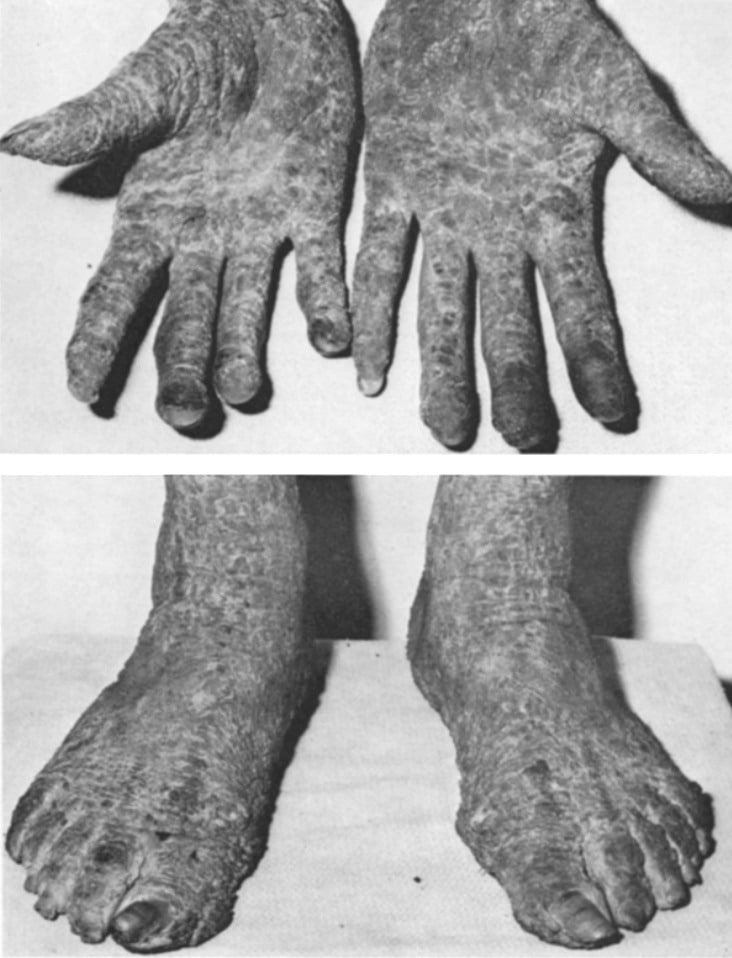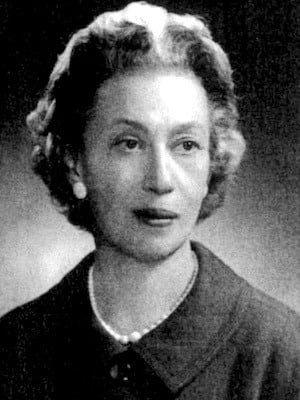Helene Ollendorff
Helene Ollendorff Curth (1899 – 1982) was a German-American dermatologist.
One of the first female pioneers in academic dermatology and the study of genodermatoses. She is also the first (and only) person to be eponymously celebrated with her maiden and married names.
Eponymous terms include Ollendorf probe sign (1923); Buschke-Ollendorff syndrome (1928); Curth-Macklin syndrome (1954); and the Curth criteria for the diagnosis of cutaneous paraneoplastic syndromes (1976)
Biography
- Born to a Jewish family on 18 February 1899 as Helene Ollendorff in Breslau, Germany
- Studied medicine at the universities of Freiburg, Munich and Breslau graduating in 1923.
- 1924 trained in dermatology at the Rudolf-Virchow-Krankenhaus in Berlin under Profesor Abraham Buschke. Here she met her husband Rudolf Wilhelm Paul Curth.
- 1927 Married Dr. William Curth taking the Curth surname, whilst retaining her own as an unhyphenated forename Helene Ollendorff Curth (H. O. Curth).
- To escape Nazi Germany the Curths moved to New York in 1931. Here they started their own private practice whilst pursuing academic careers at the University of Columbia.
- Died in 1982. She suffered from Alzheimer’s disease in her later years and donated her brain to medical research.
Medical Eponyms
Ollendorf probe sign (1923)
Describes the extreme sensitivity of papular lesions of secondary syphyllis to touch. This sign is still used to aid diagnosis today.
Buschke-Ollendorff syndrome (1928)
Also known as Dermatofibrosis lenticularis disseminata with osteopoikilosis
Autosomal dominant connective tissue disorder manifesting as multiple subcutaneous nevi or firm, nontender nodules. These nodules are usually skin to yellow coloured and painless. On histologic examination the lesions may be elastin-rich (elastoma) or collagen-rich (dermatofibrosis lenticularis disseminata). Affected individuals also have osteopoikilosis (OPK) – ‘spotted bones,’ with osteosclerotic foci found in the epiphyses and metaphyses of the long bones, wrist, foot, ankle, pelvis, and scapula. It is caused by a mutation in LEMD3 which is a gene that normally controls the production of proteins that support connective tissue. The syndrome is usually asymptomatic so treatment is mostly not required. Excision of skin nodules can be considered.
Abraham Buschke (1868-1943) and Ollendorff first reported the disease in 41 year old women in 1928. They highlighted the combination of skin and bone findings.
The posthumous eponymous term Buschke-Ollendorff was introduced by Schimpf et al in 1979.
Curth-Macklin syndrome (1954)
In 1954, Madge Thurlow Macklin (1893–1962) and Helene Ollendorff Curth (1899-1982) reported, a form of ichthyosis hystrix, a rare congenital genodermatosis. Ichthyosis hystrix of Curth-Macklin (IHCM) is an autosomal dominant skin disorder characterized by extensive hyperkeratosis and palmo-plantar keratoderma. It is caused by a mutation in KRT1 gene which is involved in keratin production. There is no cure but management includes salt waters bath, moisturising cream and oral retinoids in severe cases. It is also one of the first syndromes to be named after two women.
In 1952, Curth examined on Long Island, New York, two probands suffering from widespread ichthyosis hystrix of a family of English origin. The results of this clinical examination together with a genetic analysis by Macklin were published in 1954
…we are justified in assuming that our cases, clinically as well as histologically and ultrastructurally, represent a special form among the various forms of inherited ichthyoses and thus must be regarded as an independent nosological entity. In designating this type we prefer the term “Ichthyosis hystrix type Curth-Macklin”.
Curth 1972

Curth 1970
Curth’s modified profile sign (1961)
One of the three forms of geometric assessment performed in clubbing.
- Lovibond’s angle at the junction between nail plate and proximal nail fold and it is normally less than 160°. In clubbing, this is increased to over 180°.
- Curth’s angle at distal interphalangeal (DIP) joint is normally approximately 180° and this diminishes to less than 160° in clubbing
- Schamroth sign refers to the obliteration of normally diamond-shaped space formed when dorsal sides of the distal phalanges of corresponding right and left digits are opposed
Curth’s criteria for the diagnosis of cutaneous paraneoplastic syndromes (1976)
Curth studied acanthosis nigricans in considerable depth. She noted that there was two forms benign and malignant (associated with underlying cancer) and that the benign type was often found to present at a younger age and in those with a genetic disposition.
She proposed criteria to assess the causal relationship between dermatological change and potential underlying malignancy. Requirements included:
- both conditions start at the same time,
- both conditions follow a parallel course,
- the condition is not recognized as part of a genetic syndrome,
- a specific tumor occurs with a certain dermatosis,
- the dermatosis is not common, and
- a high percentage of the association is noted.
Cutaneous paraneoplastic lesions can precede the presentation of malignancy and therefore their recognition may help to achieve early diagnosis. These criteria have therefore been important in cancer diagnosis.
Major Publications
- Buschke A, Ollendorff H. Ein Fall von Dermatofibrosis lenticularis und osteopathia condensans disseminata. Dermatologische Wochenschrift. 1928; 86: 257-262. [Buschke-Ollendorff syndrome]
- Curth HO. Dermatofibrosis lenticularis disseminata and osteopoikilosis. Arch Derm Syphilol. 1934; 30(4): 552-560 [Buschke-Ollendorff syndrome]
- Curth HO. Acanthosis nigricans and its association with cancer. Arch Derm Syphilol. 1948;57(2):158-170.
- Curth HO. Significance of acanthosis nigricans. AMA Arch Derm Syphilol. 1952;66(1):80-100.
- Curth HO, Macklin MT. The genetic basis of various types of ichthyosis in a family group. Am J Hum Genet. 1954; 6(4): 371-382. [Curth-Macklin syndrome]
- Curth HO. Dermatoses and malignant internal tumors. AMA Arch Derm. 1955;71(1):95-107.
- Curth HO, Firschein IL, Alpert M. Familial clubbed fingers. Arch Dermatol. 1961 May;83: 828-36
- Curth HO. Malignant acanthosis nigricans. Arch Dermatol. 1970;102(4):479-481.
- Ollendorff-Curth H, Allen FH Jr, Schnyder UW, Anton-Lamprecht I. Follow-up of a family group suffering from ichthyosis hystrix type Curth-Macklin. Humangenetik. 1972; 17(1): 37-48.
- Curth HO. Skin lesions and internal carcinoma. In: Andrade R, editor. Cancer of the Skin: Biology, Diagnosis, Management. 1976: 1308–41
References
Biography
- Beighton P, Beighton G. Helene Ollendorff. In: The Person Behind the Syndrome. Springer 1996: 124-125
- Burgdorf WH, Scholz A. Helen Ollendorff Curth and William Curth: from Breslau and Berlin to Bar Harbor. J Am Acad Dermatol. 2004;51(1):84-89.
- Burgdorf WH, Hoenig LJ. A female pioneer–doubly recognized. JAMA Dermatol. 2013;149(5):527.
- Guzman AK, James WD. Helen Ollendorff-Curth: A dermatologist’s lasting legacy. Int J Womens Dermatol. 2016;2(3):108-112.
- Bader E, Shipman AR. The women behind the names: Dermatology eponyms named after women. Int J Womens Dermatol. 2017;3(1 Suppl):S38-S41
- Guzman AK, James WD. Helen Ollendorff Curth: A dermatologist’s lasting legacy. Int J Womens Dermatol. 2017;3(1 Suppl):S70-S74
- Bibliography. Ollendorff Curth, Helen. WorldCat Identities
- Davies KE, Yesudian PD. H01. Helen Ollendorff-Curth: the first lady of dermatology. British Jounral Dermatology. 2014 171 (Suppl. 1), pp139–146
Eponymous terms
- Albers-Schönberg. Fortschritte auf dem Gebiete der Röntgenstrahlen. 1915; 23: 174
- Lippelt C, Petzel H. Dermatofibrosis lenticularis disseminata mit Osteopoikilie (Buschke-Ollendorff-Syndrom) [Dermatofibrosis lenticularis disseminata with osteopoikilosis (Buschke-Ollendorff syndrome)]. Radiologe. 1982 Dec;22(12):553-61.
- Pipkin CA, Lio PA. Cutaneous manifestations of internal malignancies: an overview. Dermatol Clin. 2008;26(1):1-vii.
- Wu B et al. Buschke–Ollendorff syndrome. DermNet NZ. 2016.
- Ngan V et al. Ichthyosis. DermNet NZ. 2003
- Cohen SR et al. Buschke-Ollendorff syndrome (dermatofibrosis lenticularis disseminata, connective tissue nevus with osteopoikilosis). Dermatology advisor. 2017.
- Da Silva JA et al. Paraneoplastic cutaneous manifestations: concepts and updates. An Bras Dermatolv.88(1); 2013
Studied at University of Leeds-MBChB and Microbiology in Relation to Medicine BSc. British doctor currently working in Emergency Medicine in Perth, Australia.



